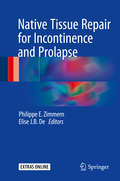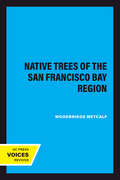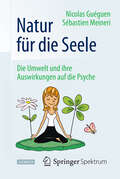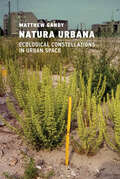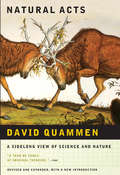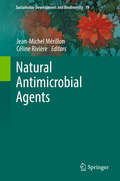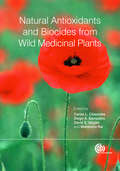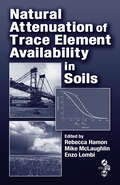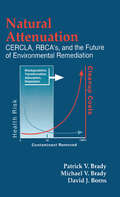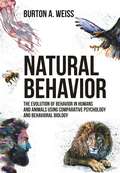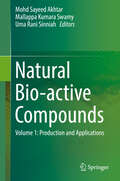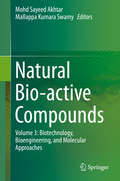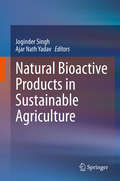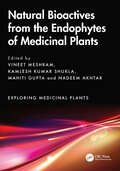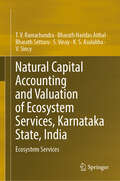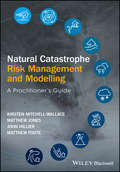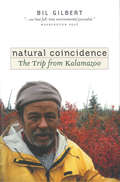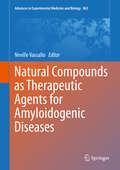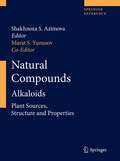- Table View
- List View
Native Tissue Repair for Incontinence and Prolapse
by Philippe E. Zimmern Elise J. B. DeThis book demonstrates knowledge on tissue-based procedures for stress urinary incontinence and other pelvic floor related topics. As the field shifts away from using synthetic material for repair, this work presents a new perspective on native tissue repair from the opinions and research of the authors. Written by a panel of expert authors in the field, this text provides high quality, focused information that is complimented by illustrations and videos. With established track records the authors illustrate how to perform the procedure vaginally or through open surgery, and inclusion of live surgeries via online video, makes this an invaluable tool for busy surgeons and specialists interested in pelvic floor reconstruction.
Native Trees of the San Francisco Bay Region
by Woodbridge MetcalfThis title is part of UC Press's Voices Revived program, which commemorates University of California Press’s mission to seek out and cultivate the brightest minds and give them voice, reach, and impact. Drawing on a backlist dating to 1893, Voices Revived makes high-quality, peer-reviewed scholarship accessible once again using print-on-demand technology. This title was originally published in 1959.This title is part of UC Press's Voices Revived program, which commemorates University of California Press’s mission to seek out and cultivate the brightest minds and give them voice, reach, and impact. Drawing on a backlist dating to 1893, Voices Revived</DIV
Natur für die Seele: Die Umwelt und ihre Auswirkungen auf die Psyche
by Jutta Bretthauer Nicolas Guéguen Sébastien MeineriIn den vergangenen zehn Jahren gab es zahlreiche Forschungsexperimente auf dem Gebiet der Psychologie in Verbindung mit Ökologie und Umwelt. Anhand von ca. 100 Experimenten zeigt dieses populärwissenschaftliche Werk auf amüsante Weise, welchen Einfluss die physische Umwelt auf den Menschen hat. Zum Beispiel werden die Auswirkungen von Baumalleen und Blumen entlang von Gehwegen und deren Auswirkungen auf Passanten in Bezug auf das Sicherheitsempfinden und Kriminalitätsaufkommen entschlüsselt. Auch der Einfluss von Blumen und Pflanzen auf die Atmosphäre am Arbeitsplatz sowie der Effekt in Krankenzimmern wird aufschlussreich beleuchtet.
Natura 2000 – A Coherent Nature Conservation Network?: A Proposal for Reforming the Rules on Designation under the Habitats Directive
by Bettina KleiningThis book offers a fresh perspective on the Habitats Directive's rules on designating Natura 2000 - the European biodiversity conservation network. Although the Habitats Directive came into force in the early 1990s, the network is not yet optimally set up and lacks coherence and connectivity. The author examines the Habitats Directive’s provisions regarding the designation of Natura 2000 and discusses possible reasons for the EU Member States’ ongoing lack of compliance with their designation duties. She reassesses the 2015 REFIT Fitness Check of the Nature Directives to look for the Member States’ reasons for not having optimally complied with their designation duties yet. She then analyses the Habitats Directive to reveal elements of non-optimal drafting in its designation provisions. Sensible law reforms that do not interfere with the general framework of the Habitats Directive and which keep in mind the relevant national, regional, and international biodiversity law and policy,as well as the relevant case law will be discussed to this end. As a result, this book presents an enhanced legal designation framework that can support Member States’ compliance with their designation obligations. The book finally goes beyond the European biodiversity legislation, also shedding light on the effects of the suggested reforms for the broader biodiversity and environmental law and policy landscape, and concludes that reforming the Habitats Directive would benefit a variety of contemporary areas of law. This book targets academics and policy-makers in the field as it provides a scholarly as well as a hands-on approach to the subject of strengthening European biodiversity law.
Natura Urbana: Ecological Constellations in Urban Space
by Matthew GandyA study of urban nature that draws together different strands of urban ecology as well as insights derived from feminist, posthuman, and postcolonial thought.Postindustrial transitions and changing cultures of nature have produced an unprecedented degree of fascination with urban biodiversity. The &“other nature&” that flourishes in marginal urban spaces, at one remove from the controlled contours of metropolitan nature, is not the poor relation of rural flora and fauna. Indeed, these islands of biodiversity underline the porosity of the distinction between urban and rural.In Natura Urbana, Matthew Gandy explores urban nature as a multilayered material and symbolic entity, through the lens of urban ecology and the parallel study of diverse cultures of nature at a global scale. Gandy examines the articulation of alternative, and in some cases, counterhegemonic, sources of knowledge about urban nature produced by artists, writers, scientists, as well as curious citizens, including voices seldom heard in environmental discourse. The book is driven by Gandy&’s fascination with spontaneous forms of urban nature ranging from postindustrial wastelands brimming with life to the return of such predators as wolves and leopards on the urban fringe. Gandy develops a critical synthesis between different strands of urban ecology and considers whether "urban political ecology," broadly defined, might be imaginatively extended to take fuller account of both the historiography of the ecological sciences,and recent insights derived from feminist, posthuman, and postcolonial thought.
Natural Acts: A Sidelong View of Science and Nature
by David QuammenA writer for National Geographic with a string of nature books to his credit, Quammen (Western American studies, Montana State U.) adds a new section to his 1985 collection of essays on critters, folks, and acts relating to the natural world and the scientific investigation of it. The seven recent essays look at such topics as planet of weeds, the post-communist wolf, and cloning your troubles away.
Natural Additives in Foods
by German Ayala ValenciaAdditives have been used in the food sector for centuries, aiming to maintain or improve food quality in terms of freshness, appearance, texture and taste. Most food additives are synthetic chemical compounds classified as antioxidants, antimicrobials, colorants and sweeteners. In the last decades, several synthetic food additives have been correlated with adverse reactions in humans, which has caused the safety of synthetic food additives to be reviewed and discussed by international organizations. At the same time, there is increasing consumer demand for more natural and environmentally friendly food products and additives. Therefore, synthetic food additives have been replaced with natural food additives. Although the use of natural additives is a hot topic in food science, to date no book has systematically reviewed the application of natural additives in food products. Natural additives in foods presents an exhaustive analysis of the most recent advances in the application of natural additives in the food sector. Covering natural antioxidants, antimicrobials, colorants and sweeteners, this text also focuses on unconventional sources of natural additives, valorization and toxicological aspects, consumer attitudes and regulatory aspects. The main applications of natural antioxidants are fully covered, including polyphenols, ascorbic acid, carotenoids, tocopherols and proteins. Natural antimicrobial applications from polyphenols and essential oils to poly-L-Lysine are analyzed, as are natural colorants like anthocyanins, annatto, betalains and paprika. The encapsulation, trapping, and adsorption of natural additives are studied, and consumer perceptions and preferences are major focuses. Researchers will find up-to-date regulatory specifics for the United States and European Union.For any researcher in need of an expansive single source containing all relevant and updated information for the use of natural additives in foods, this book is a much needed addition to the field.
Natural Antimicrobial Agents (Sustainable Development and Biodiversity #19)
by Jean-Michel Mérillon Céline RiviereDocumenting the latest research in the field of different pathogenic organisms, this book presents the current scenario about promising antimicrobials in the following areas: Part I. Plants as source of antibacterials, Part II. Naturally occurring antifungal natural products, Part III. Antiparasitic natural products, Part IV. Antiviral natural products. Renowned scientists from the globe have been selected as authors to contribute chapters. Use of plants for various ailments is as old as human civilization and continuous efforts are being made to improve medicinal plants or to product their bioactive secondary metabolites in high amounts through various technologies. About 200,000 natural products of plant origin are known and many more are being identified from higher plants and micro-organisms. Some plants based drugs are used since centuries and there is no alternative medicine for many such drugs as cardiac glycosides. Drug discovery from medicinal plants or marine micro-organisms continues to provide an important source of new drug leads. Research on new antibacterials represents a real and timely challenge of this century, particularly for the treatment of infections caused by clinical isolates that show multidrug resistance. The main microorganisms involved in the resistance process have been identified and given the acronym ESKAPE for Enterococcus faecium, Staphylococcus aureus, Klebsiella pneumoniae, Acinetobacter baumanii, Pseudomonas aeruginosa and Enterobacteriaceae. Multidrug resistant Mycobacterium tuberculosis including highly drug-resistant strains (XDR-TB) has also emerged as one of the most important clinical challenges of this century. Plants of diverse taxa and marine micro-organisms are rich source of these antimicrobials. An attempt has been made to compile the recent information about natural sources of antibacterials and their sustainable utilization. Increased panic of these pathogens warrants a growing demand for research to undertake the threat of multidrug resistance. The search for new antifungal, antiparasitic and antiviral natural products is far from devoid of interest. According to the WHO report in 2013, malaria still represents some 207 million cases worldwide and more than 3 billion of people are still exposed to this risk. Similarly, about 350 million people are considered at risk of contracting leishmaniasis. The fight against some viruses also requires that the research on natural products continue. For example, even if an antiretroviral with direct action was recently approved in Europe in 2013, its high cost does not allow to offer it to an exposed population in countries where the cost of drugs remains a problem for a large part of the population. These books are useful to researchers and students in microbiology, biotechnology, pharmacology, chemistry and biology as well as medical professionals.
Natural Antioxidants and Biocides from Wild Medicinal Plants
by Mahendra Rai Carlos Cespedes D Seigler D SampietroPlants produce secondary metabolites with herbicidal, insecticidal, fungicidal and antioxidant activities. This book provides an up-to-date treatment of antioxidant and biocidal compounds mainly from Latin American plants. New antimicrobials, insecticidals, and antioxidants are covered in three sections: a general overview and perspectives on antioxidant, medicinal and biocidal plant compounds; details of plant antioxidants isolated from a wide range of species; insecticidal, antimicrobial and other biocidal activities based on peptides, phytoecdysteroids, alkaloids, polyphenols, terpenoids and other allelochemicals.
Natural Antioxidants and Biocides from Wild Medicinal Plants
by Mahendra Rai Carlos L. Céspedes Diego A. Sampietro David S. SeiglerPlants produce secondary metabolites with herbicidal, insecticidal, fungicidal and antioxidant activities. This book provides an up-to-date treatment of antioxidant and biocidal compounds mainly from Latin American plants. New antimicrobials, insecticidals, and antioxidants are covered in three sections: a general overview and perspectives on antioxidant, medicinal and biocidal plant compounds; details of plant antioxidants isolated from a wide range of species; insecticidal, antimicrobial and other biocidal activities based on peptides, phytoecdysteroids, alkaloids, polyphenols, terpenoids and other allelochemicals.
Natural Attenuation of Trace Element Availability in Soils
by Mike McLaughlin Enzo Lombi Rebecca HamonUnderstanding attenuation processes is important not only for predicting the behavior of contaminants in soil and formulating remediation strategies, but also for mitigating and enhancing the availability of micronutrients in soil for agricultural applications. Natural Attenuation of Trace Element Availability in Soils brings together pioneering re
Natural Attenuation: CERCLA, RBCAs, and the Future of Environmental Remediation
by Patrick V. Brady Michael V. Brady David J. BornsNatural Attenuation: CERCLA, RBCAs, and the Future of Environmental Remediation presents the concept of "natural attenuation"-the tendency of soils to severly limit the toxicity of many types of hazardous waste. It reviews and updates the most recent findings from the field and lab and shows how natural attenuation is rapidly changing the direction and focus of environmental remediation. Outlining the legal and regulatory framework that has made waste remediation so costly, this book shows how applying an understanding of natural attenuation can decrease cleanup outlays while lowering risks to human health. Natural Attenuation: CERCLA, RBCAs, and the Future of Environmental Remediation makes it clear why natural attenuation will be relied upon more and more in the future.
Natural Behavior: The Evolution of Behavior in Humans and Animals using Comparative Psychology and Behavioral Biology
by Burton A. WeissNatural Behavior provides seminal insights into the evolution of animal and human behavior for enthusiasts of Comparative Psychology and Behavioral Biology. Evolution and the behavior of the animal kingdom are discussed with new concepts on science, learning and instinct, and population phenomena. Hominization, interaction with Neanderthals, how the brain evolved, and the impact on the World are described with new views.The origin of our scientific concepts and the trend away from the egocentric position, placing humans at the center of the universe, is considered, along with the status of religion and how the fit with science is positive. This volume carefully explains evolution and the central role of behavior in natural selection. The range of animal behavior from single cells to people is covered, as are, topics like European settling of the New World first, and the effects of humans on the planet.
Natural Bio-active Compounds: Volume 1: Production and Applications
by Mohd Sayeed Akhtar Mallappa Kumara Swamy Uma Rani SinniahBioactive compounds produced by natural sources, such as plants, microbes, endophytic fungi, etc., can potentially be applied in various fields, including agriculture, biotechnology and biomedicine. Several bioactive compounds have proved to be invaluable in mediating plant-microbe interactions, and promoting plant growth and development. Due to their numerous health-promoting properties, these compounds have been widely used as a source of medication since ancient times. However, there is an unprecedented need to meet the growing demand for natural bioactive compounds in the flavor and fragrance, food, and pharmaceutical industries. Moreover, discovering new lead molecules from natural sources is essential to overcoming the rising number of new diseases. In this regard, natural bioactive compounds hold tremendous potential for new drug discovery. Therefore, this field of research has become a vital area for researchers interested in understanding the chemistry, biosynthetic mechanisms, and pharmacological activities of these bioactive metabolites. This book describes the basics of bioactive plant compounds, their chemical properties, and their pharmacological biotechnological properties with regard to various human diseases and applications in the drug, cosmetics and herbal industries. It offers a valuable asset for all students, educators, researchers, and healthcare experts involved in agronomy, ecology, crop science, molecular biology, stress physiology, and natural products.
Natural Bio-active Compounds: Volume 2: Chemistry, Pharmacology and Health Care Practices
by Mohd Sayeed Akhtar Mallappa Kumara SwamyNature has consistently provided human beings with bioactive compounds that can be used directly as drugs or indirectly as drug leads. Some of the major classes of natural bioactive compounds include phenolics, alkaloids, tannins, saponins, lignin, glycosides, terpenoids, and many more. They possess a broad range of biological activities and are primarily useful in the treatment of various health issues. At the same time, the search for new and novel drugs is never-ending and, despite major advances in synthetic chemistry, nature remains an essential resource for drug discovery.Therefore, more and more researchers are interested in understanding the chemistry, clinical pharmacology, and beneficial effects of bioactive compounds in connection with solving human health problems. This book presents a wealth of information on natural metabolites that have been or are currently being used as drugs or leads for the discovery of new drugs. In addition, it highlights the importance of natural products against various human diseases, and their applications in the drug, nutraceuticals, cosmetics and herbal industries. Accordingly, the book offers a valuable resource for all students, educators, and healthcare experts involved in natural product research, phytochemistry, and pharmacological research.
Natural Bio-active Compounds: Volume 3: Biotechnology, Bioengineering, and Molecular Approaches
by Mohd Sayeed Akhtar Mallappa Kumara SwamyNatural bioactive compounds have become an integral part of plant-microbe interactions geared toward adaptation to environmental changes. They regulate symbiosis, induce seed germination, and manifest allelopathic effects, i.e., they inhibit the growth of competing plant species in their vicinity. In addition, the use of natural bioactive compounds and their products is considered to be suitable and safe in e.g. alternative medicine. Thus, there is an unprecedented need to meet the increasing demand for plant secondary metabolites in the flavor and fragrance, food, and pharmaceutical industries. However, it is difficult to obtain a constant quantity of compounds from the cultivated plants, as their yield fluctuates due to several factors including genotypic variations, the geography, edaphic conditions, harvesting and processing methods. Yet familiarity with these substances and the exploration of various approaches could open new avenues in their production. This book describes the basis of bioactive plant compounds, their mechanisms and molecular actions with regard to various human diseases, and their applications in the drug, cosmetic and herbal industries. Accordingly, it offers a valuable resource for students, educators, researchers, and healthcare experts involved in agronomy, ecology, crop science, molecular biology, stress physiology, and natural products.
Natural Bioactive Products in Sustainable Agriculture
by Joginder Singh Ajar Nath YadavThis book discusses various aspects of bioactive natural products employed in the agrochemical and agriculture sectors. It covers the use of plants, microorganisms, and microbial metabolites as eco-friendly, cost-effective, and sustainable alternatives to chemicals in the field of agriculture. Written by active researchers and academics, the book highlights state-of-art products in the field, as well as the gaps, challenges, and obstacles associated with the use of plants, microbes and their products. Given its scope, it is a valuable resource for the scientific community and professionals in enterprises wanting insights into the latest developments and advances in the context of biological products, including their applications, traditional uses, modern practices, and strategies to harness their full potential.
Natural Bioactives from the Endophytes of Medicinal Plants (Exploring Medicinal Plants)
by Nadeem Akhtar Vineet Meshram Mahiti Gupta Kamlesh Kumar ShuklaEndophytes from medicinal plants have garnered global attention due to their remarkable capacity to produce unique phytochemicals, pharmaceuticals and promising lead compounds. This book explores cutting-edge advancements in endophytic fungi research, encompassing a comprehensive exploration of their biodiversity, ecological dynamics, mechanisms of interaction and adaptive strategies. The book offers valuable insights into the therapeutic potential, agricultural applications, environmental impacts and commercial prospects of these fascinating organisms.While the contemporary books are limited to either taxonomic, ecological or practical discussions, this book presents a systematic compilation of biology and biotechnological applications of endophytic fungi from medicinal plants.Key Features Comprehensive exploration of the diversity, ecology and interactions of endophytes derived from medicinal plants found in their natural habitats Highlights the potential of endophytes derived as prolific producers of novel pharmaceutical and lead compounds Showcases the practical applications of endophytes in plant development and sustainable agriculture practices Includes contribution from researchers and academicians having vast experience in the field This book is a collection of informative illustrations, strategically integrated throughout the content, to facilitate the understanding of concepts and aid in smooth transitions between topics. Given the vast and diverse nature of the discipline, this book serves as an invaluable reference resource for students and researchers in various fields, including mycology, microbiology, biotechnology, pharmacology, botany, ecology, agronomy and molecular biology. Additionally, professionals in environmental conservation and policymakers dedicated to preserving biodiversity of medicinal plants will find this book to be a valuable asset in their work.
Natural Biomarkers for Cellular Metabolism: Biology, Techniques, and Applications (Series in Cellular and Clinical Imaging)
by Vladimir V. Ghukasyan Ahmed A. HeikalFrom the Lab to Clinical Settings-Advances in Quantitative, Noninvasive Optical DiagnosticsNoninvasive fluorescence imaging techniques, novel fluorescent labels, and natural biomarkers are revolutionizing our knowledge of cellular processes, signaling and metabolic pathways, the underlying mechanisms for health problems, and the identification of n
Natural Born Learners: Our Incredible Capacity to Learn and How We Can Harness It
by Alex BeardLearning is the soul of our species. From our first steps to our last words, we are what we learn. But for all its obvious importance, learning has lost touch with human progress. We live in an information age, work in a knowledge economy, yet our schools are relics of an industrial era. Education insider Alex Beard takes us on a dazzling tour of the future of learning to show how we can - and why we must - do better. Tackling everything from artificial intelligence to our growing understanding of the infant brain, Natural Born Learners is a user's guide to transforming learning in the twenty-first century and roadmap to accessing our better future selves.
Natural Capital Accounting and Valuation of Ecosystem Services, Karnataka State, India: Ecosystem Services
by T.V. Ramachandra Bharath Haridas Aithal Bharath Setturu S. Vinay K.S. Asulabha V. SincyThis book describes the valuation of services of ecosystems (forests, agriculture and aquatic) for Karnataka State, India, as per the validated statistical framework for natural capital accounting – SEEA: System of Environmental-Economic Accounting (SEEA.un.org). According to SEEA protocol, ecosystem services are defined as the contributions of ecosystems to the benefits that are used in economic and other human activities. The valuation of ecosystem services (VES) provides an unbiased framework to value unaccounted ecosystem benefits and helps in developing meaningful policy interventions. The approach allows for adjusted regional or national accounts which reflect the output of ecosystem services as well as the depletion of natural resources and the degradation costs (externalized costs of the loss of ecosystem services) of ecosystems in economic terms. In this perspective, the current publication, focusing on the natural capital accounting and valuation of ecosystem services in Karnataka, India, can help raise awareness and provide a quantitative tool to evaluate the sustainability of policies. The book would aid as knowledge base for many professionals, institutions and government agencies taking up the task of natural capital accounting and valuation of ecosystem services across the countries worldwide.
Natural Catastrophe Risk Management and Modelling: A Practitioner's Guide
by Matthew Jones Kirsten Mitchell-Wallace John Hillier Matthew FooteThis book covers both the practical and theoretical aspects of catastrophe modelling for insurance industry practitioners and public policymakers. Written by authors with both academic and industry experience it also functions as an excellent graduate-level text and overview of the field. Ours is a time of unprecedented levels of risk from both natural and anthropogenic sources. Fortunately, it is also an era of relatively inexpensive technologies for use in assessing those risks. The demand from both commercial and public interests—including (re)insurers, NGOs, global disaster management agencies, and local authorities—for sophisticated catastrophe risk assessment tools has never been greater, and contemporary catastrophe modelling satisfies that demand. Combining the latest research with detailed coverage of state-of-the-art catastrophe modelling techniques and technologies, this book delivers the knowledge needed to use, interpret, and build catastrophe models, and provides greater insight into catastrophe modelling’s enormous potential and possible limitations. The first book containing the detailed, practical knowledge needed to support practitioners as effective catastrophe risk modellers and managers Includes hazard, vulnerability and financial material to provide the only independent, comprehensive overview of the subject, accessible to students and practitioners alike Demonstrates the relevance of catastrophe models within a practical, decision-making framework and illustrates their many applications Includes contributions from many of the top names in the field, globally, from industry, academia, and government Natural Catastrophe Risk Management and Modelling: A Practitioner’s Guide is an important working resource for catastrophe modelling analysts and developers, actuaries, underwriters, and those working in compliance or regulatory functions related to catastrophe risk. It is also valuable for scientists and engineers seeking to gain greater insight into catastrophe risk management and its applications.
Natural Coincidence: The Trip from Kalamazoo
by Bil GilbertBil Gilbert is one of America's most preeminent and popular essayists and nature writers. If you've ever opened a copy of Smithsonian, Audubon, or Sports Illustrated magazines, you've likely come across an article by Gilbert. In the past four decades, more than 350 of his articles and essays have appeared in places ranging from Esquire to the New York Times. Natural Coincidence collects some of Bil Gilbert's finest writing, covering a diverse range of subjects that include investigations of the biology of Tasmanian devils, the lives and loves of snapping turtles, and an appreciation of the intelligence of crows. Perfectly suiting this eclectic choice of angles is Gilbert's unique writing style, a blend of unprepossessing erudition, wit, and honesty that has been compared to Aldo Leopold's Sand County Almanac. The collection opens with a memoir of a childhood Christmas in western Michigan, before Gilbert's fascination with the natural world drew him to more exotic locales like Tasmania, Alaska, Nova Scotia, and Manhattan to write about such topics as the javelina, bigfoot, buffalo, and ringtails. "More than 50 years ago," writes Gilbert, "without a clear notion about why or where I was going, I set off on a trip from Kalamazoo, Michigan. I am still traveling toward an unknown destination. But along the way, much more for reasons of good luck than thoughtful planning, I have met many wonderful beings and happenings. The essays appearing in Natural Coincidence represent an attempt to describe some of these wonders. I like to think, or at least pretend, that the inspiration for and theme of this book is gratitude."
Natural Compounds as Therapeutic Agents for Amyloidogenic Diseases
by Neville VassalloThis edited volume concerns a group of devastating neurological disorders that share a common pathological mechanism, namely the aggregation and deposition of insoluble, proteinaceous lesions, termed 'amyloid'. Examples of cerebral amyloid disorders include common neurodegenerative diseases like Alzheimer's disease-related dementia and Parkinson's disease, as well as other less prevalent conditions like Huntington's disease, cerebral amyloid angiopathy and the transmissible prion disorders. A disease-modifying therapeutic agent is still lacking for all these diseases, and there are no approved therapies that target amyloid formation directly. Nevertheless, a large and complex group of natural aromatic compounds known as polyphenols are rapidly emerging as potentially potent anti-amyloidogenic agents. This book collectively presents a considerable body of experimental and epidemiological evidence from peer-reviewed scientific publications that support a role for natural compounds and herbal extracts in the chemoprevention and therapy of amyloidogenic disorders. Each contribution is written by scientific experts in the relevant field; chapters are devoted to Mediterranean diet and olive oil phenols, traditional Chinese medicine, herbal extracts, polyphenols (with a particular emphasis on epigallocatechin-3-gallate) and bi-flavonoids, amongst others. The topic of this book is relevant to a wide audience, from academia and university students in the biological and chemical sciences, to physicians and allied health professionals, as well as people working in the nutraceutical industry.
Natural Compounds: Alkaloids
by Shakhnoza S. Azimova Marat S. Yunusov'Natural Compounds: Plant Sources, Structure and Properties' details the properties of over 7,500 chemical compounds of pharmacological interest found in plants. Each volume systematically covers occurrence of the compounds in plants, illustrations of chemical structures plus physical-chemical, spectral, and pharmacological data. Entries are indexed by plant name, subject, and pharmacological property. This provides unique coverage of information on compounds isolated from some 3,000 plants, including many from central Asia and Russia, that are not well known elsewhere. The entries for each compound share a similar format. The entries are preceded by tabulated information on the occurrence of the compounds in plants etc. The highly experienced team of compilers from the renowned Institute of the Chemistry of Plant Substances in Tashkent have expertly assessed the international literature and include data only when confident of its validity, e.g. excluding data where measurement processes cause degradation of the original compound.
